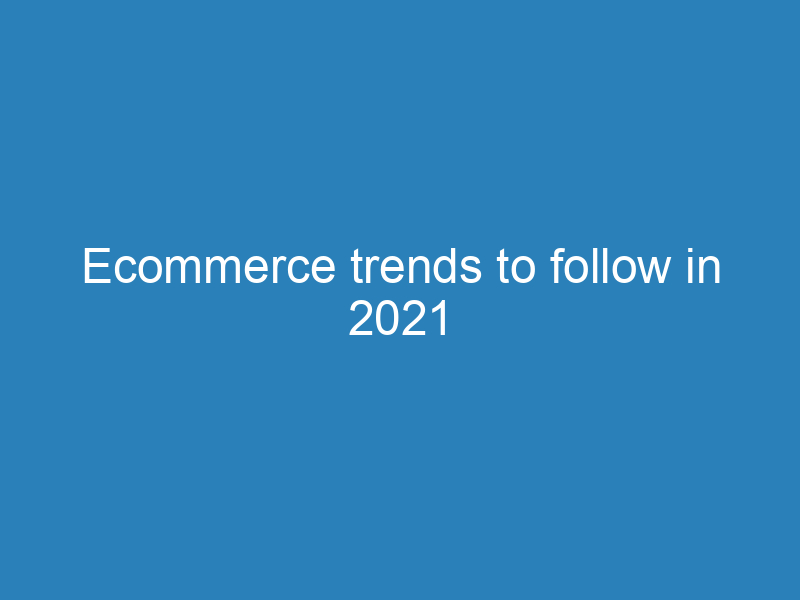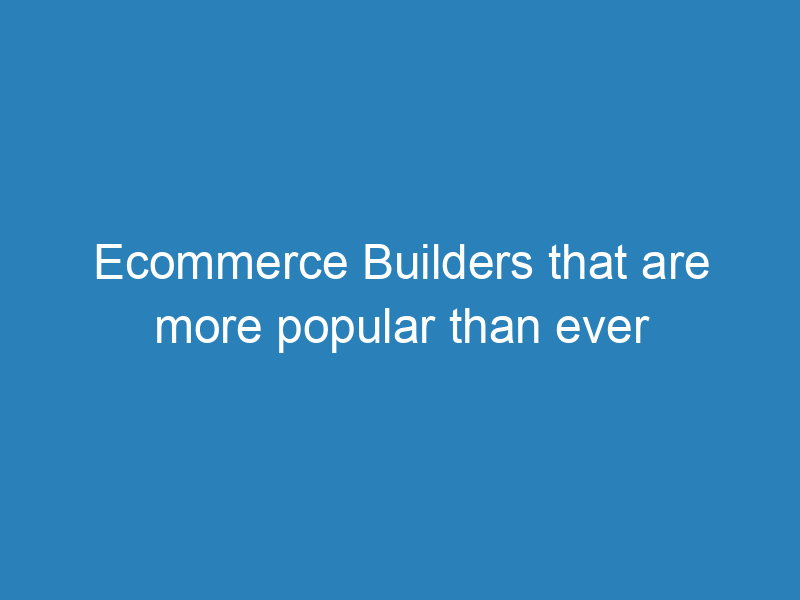Table of Contents
ecommerce trends
user experience
Social media is one of the top ecommerce trends for 2021. Intutive grid designs have evolved significantly from last year. Brands are now able to create multi-product web shops with multiple grids. These grids can be arranged in a variety of ways, including diagonally, up-and-left or up-and-down. While these experiments are still fresh, the trend to come is more predictable.
Online shopping is becoming easier and more intuitive for consumers. This is the key to the next wave of ecommerce trend. Social media integration is the main feature here, as many companies have realized that they can combine their proprietary customer data with social networking sites like Facebook to make their online stores more accessible. By making it possible for customers to update their shopping information or products on a moment by moment basis, brands are able to convert more traffic into paying customers. Customers are now sharing their services on a greater scale than ever.
One of the biggest ecommerce trends of all time is online retailing. Online retailing encompasses all manner of industries, from electronics to apparel to accessories and home goods. Millions of people around the globe shop online for the products they want at any given time. The future of ecommerce lies in the hands of the internet, which has revolutionized the way online retail stores work. Traditional brick-and mortar retail stores have had difficulty maintaining their current profits since they have lost customer loyalty towards the internet. Traditional retailers will have to look for alternative ways to generate revenue by pushing online retail sales past their online store numbers.
One of the most important ecommerce trends is the increased importance of user experience. Online shoppers are demanding more from their websites, and they are demanding it in all areas of the online buying process. For example, they want shopping carts that load quickly and effortlessly, they want payment options that are secure and private, and they want an easy method of canceling unauthorized orders. No matter how good a site is, it will lose customers if it doesn’t offer them the things they need at a fast and convenient pace. Ecommerce businesses don’t have to sacrifice the things that make their site appealing for the most advanced and flashiest payment options. In fact, it’s quite the opposite!
The truth is that ecommerce trends reflect the preferences more than the preferences for merchants. Retailers who focus on pleasing the end users will be successful because they appeal to the desires of their customers. Who wants to shop on a website that makes their lives difficult? If your website is user-friendly, they will tell their friends and recommend it to others. This type of customer experience can bring you more profit.
Ecommerce trends are driven by the need to provide seamless experiences. People want to be in a position to quickly find what they are looking for and not have to leave their home. A person may only have a few moments to spend on their computer before they need it. This means that they need a website that gives them a pleasant shopping experience. If your website provides a confusing or unpleasant experience for customers, it is unlikely that they will return to you again. You will see strong growth in sales if you provide a high-quality service and product, and focus on creating a seamless experience.
simplicity
If you are in the business of selling goods online you must be aware of Ecommerce trends. Many businesses have found the internet to be a great platform for growth. If you are also planning to start an online business, then it is best for you to understand Ecommerce trends. Consumers are more inclined to shop online than ever before, but they rarely get to see the goods in person. This has led to higher profits in recent years. It is always a bad day to offer a refund to a customer.
So what can we do in order to avoid such a situation? Well one way of ensuring a positive and a long term impact of ecommerce trends on your business is to hire an influencer. Influencers are experts in helping businesses reach consumers and focusing on the customer experience. If you want to take advantage of influencers, the first step is to identify those that will fit your target market.
You should search for an ecommerce solution that can be customized to maximize your opportunities. You can integrate your storefront with social media platforms like Instagram, Facebook, and Twitter. You can also use a 3rd party integration solution. On the other hand you should also consider fulfillment options like drone delivery, widgets and fulfillment solutions from Amazon. If you are ready to offer your solutions to these influencers, then you should first identify those that would benefit from your offering.
The latest ecommerce trends are centred around drop shippers. They provide an affordable way to stock your online stores. You just need to upload your products to their site and let them handle the stock. They will deliver the items directly to your customers. Drop shipping solves many of your problems. For instance, you won’t have to worry about inventory, storage or handling.
Video ads can be another way to grow your business. Video ads are the latest ecommerce trends as they help you to attract potential customers from all over the globe. Video ads require that you manage your budget. You won’t pay for any traffic that visits your website. All you will be paying for clicks from people who viewed the video ad on a video sharing website like YouTube.
Augmented reality is another trend that is sure to be a big deal. Augmented reality is the application of digital data to visualize products and services. This can be done via a variety of media, including tablets, smartphones, and digital signage. You will have to tap into this market yourself and make your digital products accessible to everyone. Augmented reality can be used to do a variety of things, including creating an app that helps people find your products, voice searching, and video ads. These are just some of the many ideas you have to put into practice to grow your business with ecommerce trends.
personalization
The following eCommerce trends will be popular in the next decade: personalization, social shopping and local online inventory management. These are just some of the topics that are likely to be discussed at an eCommerce planning meeting. When these topics are brought up, it is important that everyone involved in the business has an opinion. This will help to identify what is a common opinion and what is not. This can be done through soliciting opinions from customers and business partners. You can also do informal online surveys, where each business owner can complete a survey and submit the results.
Personalization is becoming a major part of eCommerce. Personalization is the ability to offer products and services that have a unique offering. This includes customized hoodies or embroidered totes. Customers want to be able to customize their shopping experience according to their preferences.
In the next ten years, ecommerce trends for the 21st century include vertical markets, including information technology and telecommunications. The key eCommerce trends in information technology will be augmented reality, crowdsourced purchasing, and content curation. This includes activities such as social shopping and group buying. In the future, it may even encompass real-world buying and social buying. Another trend which will see significant growth in the future is vertical markets. These include high-end fashion, travel, and other vertical markets.
The top ecommerce trends in the next decade for physical retail include increased emphasis on omnichannel distribution. Omnichannel distribution means combining multiple forms of distribution, such as traditional onsite stores, with e-commerce capabilities. Large stores might offer a wide range of products via an internet portal. Customers may also be able to shop online from their smartphones, laptops, or other handheld devices. This is already being seen in a number of grocery stores, where customers can purchase food, groceries and other goods from the various stores, from the comfort of their seats in the car. There are also efforts to extend this to other retail categories, such as a service whereby shoppers can shop at home, get paid through their smartphones and then pay for their purchases via a card. Online retailers are not the only ones that will grow in the future. Other verticals include hotels, medical equipment manufacturers, and mobile device manufacturers.
Ecommerce businesses that are driven by social media networks will see a greater focus in the coming decade. Ecommerce businesses that focus on social shopping will make up around 15% of all ecommerce sales in the next five to ten year. Other trends include a focus on self service websites such as those offering tips and tricks for running a home-based business, and an increase online presence through domain names or social networking pages. It is expected that ecommerce businesses expand into the following verticals: auto-shopping; travel and leisure; education and health care; personal products. These trends are already shaping the future for ecommerce.
Despite commerce growing steadily for some time, it can be overwhelming for small businesses. However, there are a number of solutions available for small businesses to bridge the gap between marketing strategies and search engine optimization. These solutions include ecommerce platforms and content management platforms that can help ecommerce businesses reduce their cost of operation and improve their overall customer experience. These solutions can be used to power the core processes of an ecommerce site, and therefore, should be considered as important elements in ecommerce trends.
social media marketing
The following report, ecommerce trends and predictions, highlights how important it is to keep an eye on the latest innovations in ecommerce. Recent studies have shown that over 70% of online shoppers rely on social networks to find information and make purchases. This reliance has given rise to a new standard for eCommerce merchants, online businesses, and their clients to measure success in ecommerce. The success of a brand’s digital transformation will be measured over the next months and years, using its unique brand identity.
The integration of customer service into eCommerce’s shopping experience is eCommerce’s latest innovation. Through the use of social media tools such as Facebook, Twitter, and LinkedIn, companies can now connect directly with their clients, enhance customer support, and respond to their fans in a personalized way. By engaging customers on a more personal level, brands can also cultivate long-term relationships with their target audiences. eCommerce websites are also increasingly using social media to drive customers to their blogs. Here they can receive updates on sales, discounts, blogs, and other news. This will increase customer satisfaction and loyalty. These new marketing strategies are crucial to eCommerce success.
As mentioned above, another strategy employed by many ecommerce businesses today is the development of a “headless” or interactive website, designed to provide a unique browsing experience. IBM’s research revealed that more than half the internet users don’t interact with websites’ navigation or content. This includes those who interact with advertisements. More than 25% of internet users will not access a website if it doesn’t offer a way to leave a review. Many ecommerce sites now have headless interfaces. This allows users to navigate the site without leaving their current page. Although headless websites have their benefits, this type of marketing could prove to be very profitable for ecommerce businesses over the years.
Another trend anticipated in the next decade is the rise of e-commerce bots. These automated programs are currently being sold online by companies that want to automate business processes such as sales, product inventory, customer service, and customer support. These programs were initially created to help businesses find a cost-effective way to keep customers coming back. However, artificially intelligent programs are now playing a larger role in many businesses. For example, companies may use a bot to help maintain and develop a specific website, increasing the website’s search engine optimization (SEO) and link popularity. A bot can also be used to encourage customers to return by suggesting new products, suggesting changes to websites that they might like to see, and sending them on to other relevant pages. A bot can also increase revenue by suggesting products or services that might be of interest to customers.
The fourth upcoming ecommerce trend for the next decade is the use of social media platforms to improve a company’s customer experience. Millions of users use social media platforms, such as Twitter and Facebook, to voice their opinion, to upload photos and videos, or to connect with others. These platforms can be used by companies to create viral campaigns. For example, Twitter’s viral campaign last year that allowed users to tweet whatever they wanted as long as it was not harmful to the company. Others are using social media to enhance their brand recognition. These posts, articles, videos, and articles give the public insight into the company’s operation, product portfolio, and the types of goods and services it offers.
Of course, the use of social media platforms and ecommerce software to improve a company’s business will not result in a seamless shopping experience; some users are hesitant to share their personal information online. With the right marketing techniques, this problem can be overcome. In fact, many businesses have found that implementing social commerce solutions has helped increase their customer base, boost revenue, and create lasting relationships with their customers. In the long run, this could be the most cost-effective and effective way to conduct business.
brand values
Ecommerce trends may change, but one thing is certain: digitization and online shopping are here to stay. For some, it s as marked a significant boost in market share and sales, particularly for those who have been moving toward that direction for quite some time. Others have found a new way to shop with the advent of ecommerce sites such as Amazon and eBay. You have the option to choose.
The rise in merchants selling their products on Amazon has been one of the most popular ecommerce trends over the past few years. As more Internet users continue to flock to the World Wide Web for all of their shopping needs, more of these companies will enter the marketplace to tap into the massive consumer pool there. Merchants are using the Amazon platform to extend their range of offerings and build brand awareness while also drawing in new customers through the app, which allows them to offer specialized content through the purchase of third-party items or services.
The future of ecommerce will see the rise of marketplaces that allow small merchants sell their products directly to consumers. Marketplaces like Cookware, for example, are starting to crop up across various cities in the U.S. as companies look for a more affordable way to market their goods. Shipwire and Cookware are also offering an open marketplace that merchants can use to sell their goods directly to the public without the help of middlemen like Shipwire or Shipwire. Marketplaces offer merchants new ways to make money that don’t rely as heavily on traditional advertising. Although these marketplaces will take time to gain momentum, it is worth paying attention as the competition heats-up in the coming years.
Ecommerce platforms like Buyer Clubs and SaleHoo, which allow merchants to market and sell products online without the hassles of traditional retail, are one of the most important trends in the next few years. Many clubs offer the ability to purchase goods online with credit cards. This makes it easier and safer for consumers. These clubs also offer a popular service: wholesale orders can be made over the Internet. This greatly reduces the overhead of retailing. Marketers need to understand that this setup requires very little investment in time or money. This makes it an attractive option for merchants looking for ways to reduce their costs. These clubs offer a unique online shopping experience and allow buyers to compare prices and brands to find the best deal. Online retail is expected to continue to grow and will require specialized buyer clubs to provide a comprehensive shopping experience.
Experts predict that brands will use social media more extensively than ever before to offer a unique online shopping experience. In recent years, several major companies have made social media a central focus, using the platform to address issues and generate feedback from consumers. In fact, many retail brands are using social media outlets such as Facebook and Twitter to update their overall brand values, as well as providing a venue for discussions about their products. While the primary goal may be to generate interest in and debate about their brands, these efforts might also encourage consumers to support the brand on an individual level.
Ecommerce trends suggest that brands will continue taking advantage of technology and developing more complex ways to communicate to consumers. This approach will likely appeal to the brand conscious consumer, who wants a level of control over how and when they purchase certain items. This strategy doesn’t seem to pose a threat to existing businesses at this time, but it is not clear what the impact could be on smaller independent stores. As people become more aware of their purchasing ability, the pace of ecommerce growth will accelerate.
diversification
According to the predictions, the next decade is going to be an exciting decade for ecommerce. Now that the first quarter has come, it’s time to analyze the future prospects for ecommerce. What have we predicted for the next 10 years? What are the big things which are shaping up the future prospects of ecommerce? This article will discuss some of these important ecommerce trends for the coming decade.
Diversified Payment Channels Ecommerce is slowly growing on the virtual platform, however, due to the popularity of mobile phone. It has become a popular choice for people to shop via their mobile phones, as it makes the process easier and less complicated. Customers have greater choice and access to a wide range of products and services via the virtual platform.
Mobile Shopping: Shops that embrace mobile shopping are gradually emerging as major players in the ecommerce market. This is because they have managed to bring out unique payment options and offers, which were unavailable till now. As per one latest research, US residents are spending more than half of their time online while shopping using their mobiles. Apart from that, more merchants and brands are venturing into the mobile platform to gain an increased customer base. This has made ecommerce trends in the US look bullish and diverse as well.
Image taken with a bang: In the early days of commerce, online stores were just that – an online store. But as the times progressed and with the development of various online marketing techniques like social media, Pay per Click, SEO, Affiliate programs, etc, the image became a crucial part of any online marketing campaign. Hence, today you can find ecommerce stores with impressive and eye-catching web designs as well as offering an array of image options which can attract a wide range of customers.
Image Stunning: Stunning is another facet which has contributed heavily to changing ecommerce trends in the US. A good ecommerce website always renders an image that is rich and colorful. Websites no longer have to look boring or dull. You can find a huge variety of colors, images texts, styles, and textures that will make your online store stand out from others. A product image that showcases a striking design or a vivid color combination can make a potential customer visit the site and decide to purchase.
A well-designed store: The most important aspect in ecommerce trends US is the appeal of the online store to the customer. It is essential to attract traffic and make sales. Online stores must be easy to browse and simple. This is what most US shoppers want. An attractive design allows the customer to easily browse through the pages, make a decision, and place an order from the comforts of his own home.
payment
Ecommerce is becoming increasingly competitive. Ecommerce must be monitored regularly to stay ahead of your competitors. No matter how established your online ecommerce business is currently, if you do not keep up with key ecommerce trends, chances are you will quickly fall behind. Learn more about the top ecommerce trends and how you can benefit from them.
“Content is King” — This is the age where ecommerce trends dictate success. Content plays an integral role in modern businesses. That is why many successful online merchants and ecommerce merchants invest heavily in creating quality content that their online visitors enjoy reading. For example: newspapers, magazines, etc. Online visitors who enjoy reading your content will likely visit your website to check out what else you offer.
“Visibility Is King” – Consumers should have easy access to the information they need, regardless of whether or not they are purchasing high quality content. Augmented reality software is one way to achieve this. Augmented reality software can provide consumers with a virtual image of a product, without them having to touch, hold, or even see it. This allows consumers to experience the product in their own hands before they buy it.
“Mobile commerce” – By the end of next year, the mobile industry will surpass the online shopping industry in terms of its reach. Analysts believe this trend is set to continue. Mobile shopping is becoming more popular and consumers are willing pay more for convenience. Mobile commerce is expected to be the next big ecommerce trend. With this equipment, consumers can buy items while they are on the go.
“Covid-19” – This ecommerce trends of the future will allow consumers to search, buy, and sell on their favorite social media platform of choice. Facebook, Twitter, Google+ all fall under “Covid-19.” You’ve probably already heard about this feature if you have been following Waze’s recent purchase. Google and Facebook have both indicated they will integrate the new feature into their platforms.
“Covid-19” allows the use of credit cards in online shopping. It is estimated that nearly half of all Americans will be able to make purchases with their credit cards through this service by the end of fiscal 2021. This purchase and others are indicative of ecommerce trends that consumers will shop on their smartphones and tablets to purchase goods. The use of alternative payment methods such as PayPal may become commonplace. In the near future, consumers might be able to pay their purchases via their smart phone or tablet or even their lap computer.




